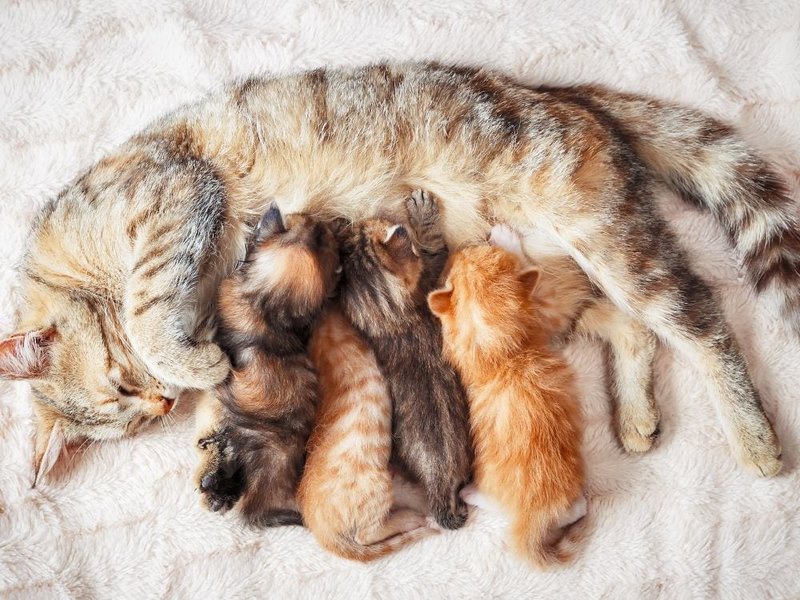While we all love and absolutely adore kittens, most cat owners don’t know what to do once their female cat goes into labor; Hence, why I’ve put together today’s article to serve as a guide.
So, how can you help a cat in labor? Female cats in labor will generally deliver kittens with ease; hence, there isn’t much you can do to help. However, you should be at hand to provide emergency aid to your female cat, should complications arise while giving birth to kittens.
In as much as there isn’t much you can do once your cat goes into labor, you can make arrangements to ensure your female cat has no problems giving birth. And once your cat has safely delivered all of its kittens, what is the next course of action? How do you ensure the safety of the newborn kittens and the mother cat?
All of this is discussed in today’s article, but before we go further, let’s see what you can do, however little, to help a cat in labor.
What Can I Do To Help My Cat In Labor?
Cats in labor normally don’t need much help giving birth, but there are things you can put in place beforehand, to ensure that the birthing process goes as smoothly as possible.
Ensure Your Cat Is Comfortable
One of the things you can do to make sure your queen stays comfortable throughout the duration of her pregnancy, is to set up nests at strategic locations in the home.
Nests for a pregnant cat should be located in places where the feline can feel relaxed and safe – preferably where there are no kids running around. Additionally, the nest should be made of soft, comfortable materials with no smells that may interfere with mother-kitten bonding after birth.
You should also ensure that your cat has easy access to a constant supply of fresh, clean water and its litter box. Understandably, as your cat’s pregnancy advances, it may experience difficulties climbing high places, hence you should ensure the litter box is as close to the ground as possible.
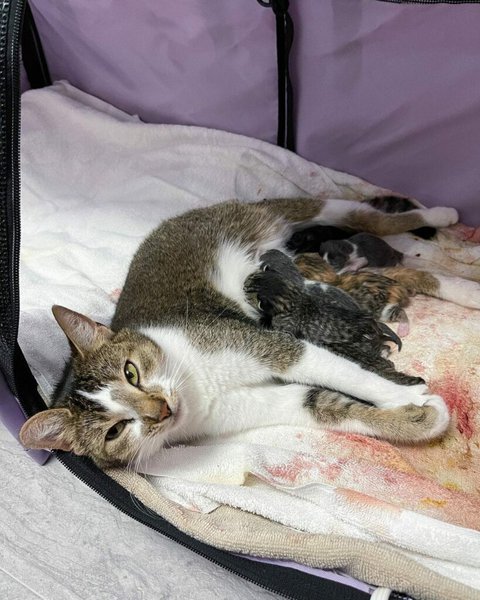
Feeding A Pregnant Cat
Diet plays an important part in the development of fetuses in pregnant cats, and it is also essential to a stress-free birthing process.
Pregnant cats understandably need more calories and proteins, and this is typically present in high-quality kitten food. You should also avoid overfeeding a pregnant cat, as this may lead to weight problems, which is not good for the safety of the queen and kittens.
As your cat advances in pregnancy, feed it smaller-sized meals, at an increased frequency; 4 to 6 small meals of kitten food per day will be sufficient to keep a pregnant cat going.
Keep Emergency Materials Nearby
In the event that things go sideways while your cat is giving birth, it’ll be helpful to have first aid materials at hand to stabilize your kitty cat before proper medical attention is provided.
Some of the useful first aid items to have on standby include clean and dry towels, disposable gloves, and a cat carrier. A kitten feeding bottle with special cat milk powder, will also come in handy should the mother cat experience problems feeding her kittens after birth.
Monitor The Birthing Process For Signs Of Complication
As stated earlier, cats don’t need help delivering kittens, but there’s every possibility of birthing complications arising. And in such cases, prompt medical attention is required to guarantee the safety of the mother and the kittens.
Some of the signs that a cat is having trouble giving birth include:
- Sudden fatigue
- Failure to push out a kitten after straining for over an hour
- Bleeding during or after pushing out a kitten
- Agitation and anxiety
- Obvious pain
Give Your Cat Space
Cats in labor may not appreciate that you’re constantly hovering around them to observe the birthing process; Hence, to ensure you don’t agitate a queen in labor, maintain a safe distance, and only pop in to check how things are going at intervals of fifteen minutes.
How Do You Take Care Of Newborn Kittens?
Newborn kittens are quite delicate, and the first few hours to days and weeks, after the birth of a kitten is highly crucial to its long-term growth and development. Mother cats have the capacity to cater for newborn kittens’ needs. And the recommendation is that you leave both the mama cat and the new litter alone for the first few weeks of kittens’ lives.
However, if you’d rather play an active part in the early stages of your kittens’ lives, here are some of the things you can do:
Keep The Kittens Warm
Newborn kittens will usually snuggle up to their mother for warmth and protection. But you can make the process easier by providing thick, comfortable blankets to keep mama cat and her kittens warm. You can also make provisions for a warm bed or a thermostat to regulate the temperature in your home.
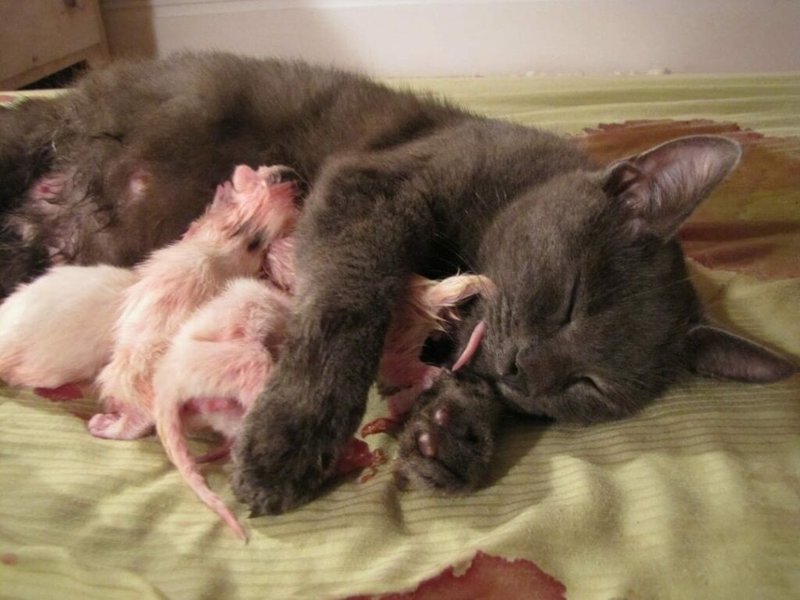
Dry The Kittens
If, after birth, you notice that the mother cat is too tired to lick and dry its kittens, you can step in, and help clean fluid off the kittens. And you should do this with a clean, dry towel and disposable gloves.
Leaving the newborn kittens wet can result in their body temperatures falling dangerously, and this can be potentially harmful to them.
Ensure That The Newborn Kittens Nurse As Soon As Possible
Colostrum is the milk produced by a mother cat immediately after birth, and it contains essential antibodies necessary for the growth of a kitten; Hence, you should monitor your newborn kittens to ensure they suckle their mother’s breasts immediately after they’re born.
If you notice that the mother cat is rejecting its kittens after they’re born and refusing to feed them colostrum-rich milk, you may need to step in to ensure that the newborn kittens get the required nutrients. And you can do this by feeding the kittens a high-quality milk replacer like the Kitten Milk Replacer from a special fostering bottle.
The Kitten Milk Replacer is suitable for newborn cats, and it contains the vitamins and minerals typically present in colostrum; This, in turn, ensures that the kitty cat gets the required nutrition for proper growth at the early stages of its life.
Avoid Separating Newborn Kittens From Their Mother For Long Periods
If it’s not absolutely necessary, like in the case of medical emergencies, it is recommended that you avoid separating newborn kittens from their mother for too long. Keeping newborn kittens away from the mama cat for too long can induce stress in the feline, thereby leading to displays of aggression typical with maternal instincts in queens.
While it isn’t unheard of for a mother cat to reject its kittens after humans touch them, the chances of it happening is close to zero. And a mother cat rejecting its kittens may be potentially detrimental to such kittens’ growth.
If it is compulsory that you hold a newborn kitten, it may help to let the mother cat sniff you for some seconds as a means of calming it down, before you then proceed to separate the kitty cat.
Keep An Eye On The Kittens’ Health
You shouldn’t wait long after your kittens are born, before scheduling a visit to the vet for a thorough inspection of your new litter – the recommendation is to do this within the first to second week of birth. The vet will carry out a general inspection of your newborn kittens and the results of the tests will give you a base idea of your new litter’s health and well-being.
Additionally, vaccination is essential to protect your kittens from some deadly diseases and infections. And you should consult with your vet to make arrangements for your newborn kittens to get the required vaccination shots.
Feeding Kittens In The Absence Of The Mother
Ideally, newborn kittens rely on their mother’s milk to survive and get the nutrients essential for proper growth and development. But in the event that a mama feline isn’t around to feed its kittens after birth, the responsibility of feeding newborn kitty cats falls entirely on you.
Newborn kittens will mostly need to be fed with a high-quality milk replacer for the first one to two weeks of their lives. But you can gradually make the switch to formula and dry cat food as they grow older.
Newborn kittens can’t go long without eating, and you should bottle-feed them with the milk replacement at intervals of one to two hours during the day. You should also gently stimulate newborn kittens’ genitals after feeding them, to encourage elimination.
Additionally, you will need to weigh the newborn kittens from time to time to ensure that they’re truly growing and adding healthy weight.
What Should I Do After My Cat Gives Birth?
Monitor Your Cat For After-Birth Complications
Mama cat may have given birth, but she isn’t completely out of the woods, and there’s every chance an after-birth complication may arise. Consequently, it is important that you keep an eye on your female cat after it has given birth, to quickly nip the development of these complications in the bud.
Some of the possible after-birth complications you need to watch out for in a female cat include mastitis, excessive bleeding, eclampsia, hypocalcaemia and uterine prolapse among others.
Some of these complications require that you temporarily take on feeding the newborn kittens, but most will require urgent medical attention. Additionally, it is important that you take a mother cat and her new litter to your vet for a comprehensive medical examination, at most, one week after birthing, to check for possible infections and diseases.
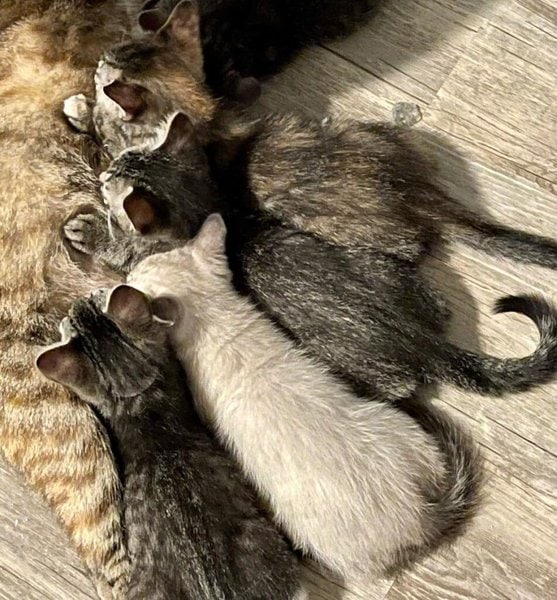
Ensure Your Cat Is Well-Fed
Understandably, mama cat will be exhausted from giving birth, hence you should feed the feline meals high in calories to help regain pre-birth strength.
In the same vein, nursing female cats will need extra nutrition to cope with the demands of milk production. And feeding a nursing feline high-quality cat food, like the Nom Nom Cat Food, will ensure that it gets all the essential nutrients and supplements for healthy lactation.
And in addition to providing the nutrients essential for healthy milk formation, the Nom Nom cat food is made from tasty food ingredients designed to eliminate food pickiness by nursing mother cats.
You will also need to feed the mother cat extra meals till the newborn kittens are weaned. And once the kittens are weaned – mostly four to five weeks after birth – you can return to feeding the female cat its normal food ration.
Additionally, you should make sure that mama cat has easy access to clean, fresh water at all times, to aid with milk formation. You should also ensure that the water bowl is out of the newborn kittens’ reach, as they can drown in the water if care isn’t taken.
Do Cats’ First Litter Usually Die?
How Many Kittens Should You Expect In A New Litter?
Typically, female cats will give birth to between three to five kittens per litter. However, this is heavily influenced by the female cat’s age, health status, and breed. It is also not uncommon to see female cats give birth to ten kittens, while others will only push out one kitten.
While it is likely that some of the newborn kittens won’t make it past the weaning stage, it isn’t normal for a cat’s entire first litter to die. And the death of all the newborn kittens in a litter is an indicator of a serious medical condition.
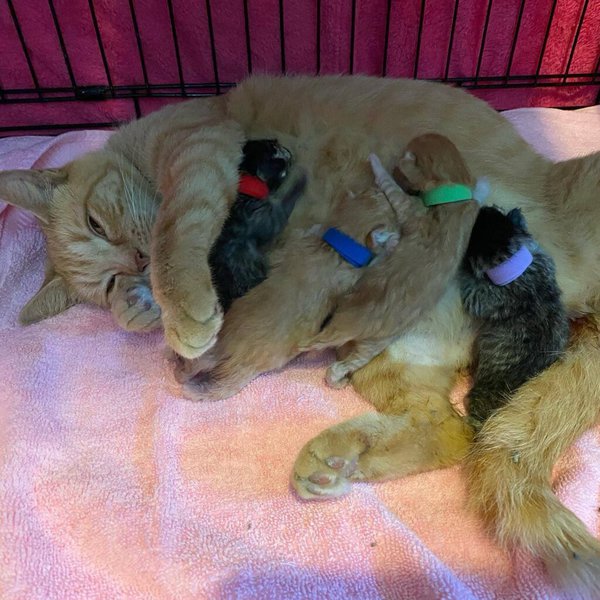
What Is The Fading Kitten Syndrome?
The Fading Kitten syndrome is a common condition with new cat litters, and it refers to the death of some or all of the newborn kittens in a litter before they are weaned.
What Causes The Fading Kitten Syndrome?
It is important to note that the Fading Kitten Syndrome is not a stand-alone medical disease, but it is rather an umbrella term that refers to medical conditions that are commonly responsible for kitten mortality.
That said, some of the major causes of early death in kittens include:
- Malnutrition
- Difficult birth
- Lack of oxygen (Hypoxemia)
- Infections
- Extremely high or low temperatures
- Poor handling
- Inadequate feeding
- Birth deformities, among others
How Can You Tell If A Kitten Is Fading?
Symptoms of a fading kitten will vary according to the specific medical condition threatening the kitty cat, but some of the more common signs you can be on the lookout for include:
- Rapid weight loss
- Refusal to nurse
- Poor weight gain
- Abandonment by the mother
- Low body temperature
- Lethargy
How To Treat The Fading Kitten Syndrome?
As stated earlier, the Fading Kitten Syndrome is not a diagnosable disease; hence, treatment will depend solely on the symptoms shown by the affected kitten.
However, common treatments of the conditions responsible for fading in kittens include medication, the use of antibiotics, supplementary feeding, and in some cases, surgery may be needed.
It is also important that you enlist the help of your vet in taking care of your remaining kittens, once you find out what’s killing your newborn felines.
Related Questions
Do Cats Eat Their Kittens? Yes, it is possible for mother cats to eat their own kittens. This behavior is typical among feral cats, and it is either because the kitten is critically ill, malformed or a stillbirth. For no reason, however, will a mother cat eat a perfectly healthy and viable kitten.
Why Is My Pregnant Cat Meowing So Much? Pregnant cats are quite vocal, and when your queen suddenly starts to meow a lot, it may be trying to tell you that it wants a safe, sheltered plate to deliver its kittens. In the same vein, increased meowing by a pregnant cat can be a sign of discomfort or an indicator that your queen is in the early stages of labor.
Do All Cats Lose Their Appetite Before Birth? Loss of appetite in a pregnant cat can be an indicator that the feline is about to go into labor; However, this is not the case with all pregnant cats. Typically, a pregnant cat will start eating less food, and may stop eating altogether, about one or two days prior to delivering its kittens.

